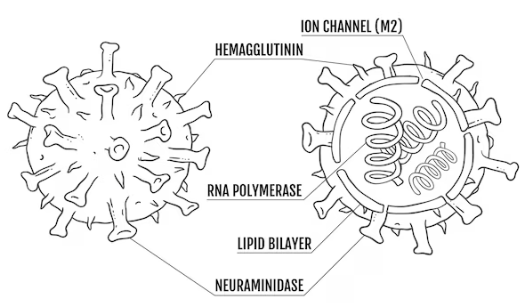In the ongoing battle against the influenza virus, U.S. researchers have made a groundbreaking discovery, uncovering new antibodies that target the elusive “dark side” of the virus’s neuraminidase (NA) protein. This revelation, detailed in a recent study published in Immunity, sheds light on a previously unexplored region with unique epitopes, holding immense promise for the development of next-generation vaccines and therapeutic interventions.
The influenza NA protein, known for its globular head and narrow stalk portions, harbors a concealed region on the underside, aptly named the “dark side.” This region proves challenging to detect due to its partially hidden location, making it relatively unexplored until now. Researchers at the U.S. National Institutes of Health (NIH) isolated human antibodies targeting this dark side from individuals who had successfully recovered from influenza type A subtype H3N2, a prevalent strain in seasonal flu viruses.
In laboratory tests, these antibodies demonstrated their remarkable capabilities by inhibiting the propagation of H2N2 viruses, responsible for the 1957-58 pandemic, and various H3N2 viruses found in humans, swine, and birds. Impressively, these antibodies also protected mice from lethal infections caused by subtype H3N2 viruses, offering a potential treatment and prevention strategy.
The study delves into the structural analysis of the antibodies while bound to NA, employing advanced microscopy techniques such as cryogenic electron microscopy. Intriguingly, each antibody targeted different, nonoverlapping regions of the dark side, emphasizing the diverse areas of vulnerability in this hidden domain.
This groundbreaking research signifies that the NA dark side contains previously untapped epitopes, showcasing its potential application in developing novel vaccine and therapeutic strategies. The unique characteristics of this hidden region suggest that antibodies targeting the NA dark side could prove valuable in combination with antivirals or other types of antibodies, especially against influenza viruses with drug-resistant mutations.
The researchers emphasize that these NA dark side targets could play a pivotal role in the next generation of broadly protective vaccines against influenza. The findings offer hope for a more comprehensive approach to influenza prevention, potentially eliminating the need for yearly vaccine reformulation and vaccinations.
In conclusion, this discovery marks a significant leap forward in our understanding of influenza virus vulnerabilities, paving the way for innovative countermeasures to combat the ever-evolving flu strains. The research not only contributes to our arsenal against influenza but also highlights the importance of exploring the uncharted territories of viral proteins for future breakthroughs.
